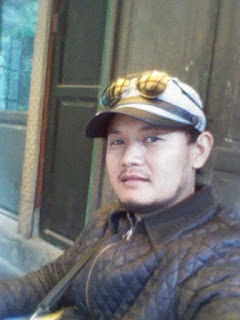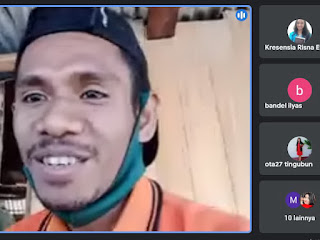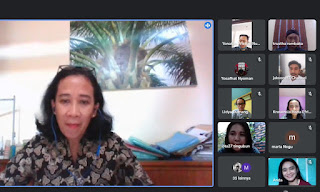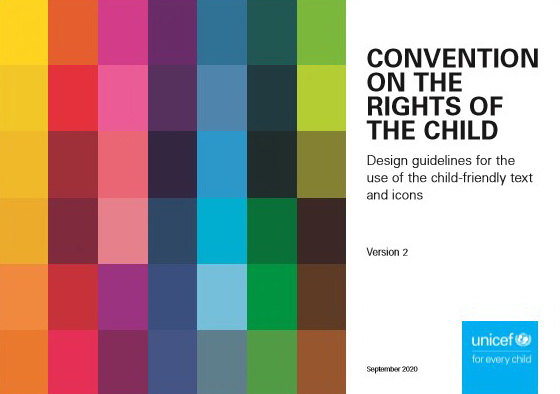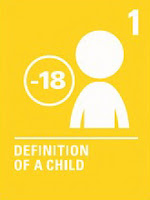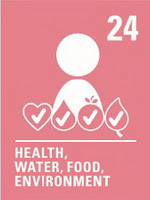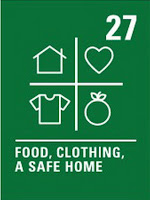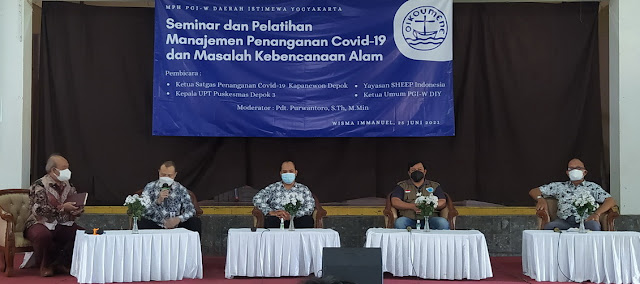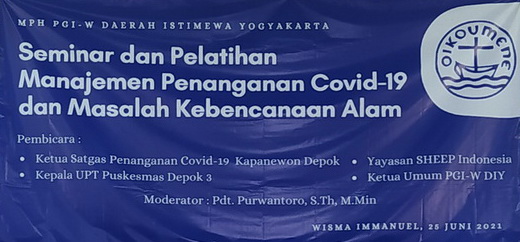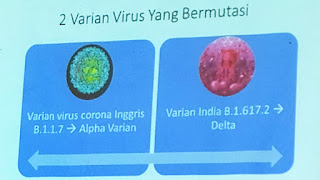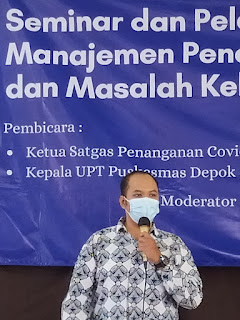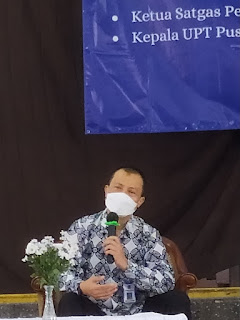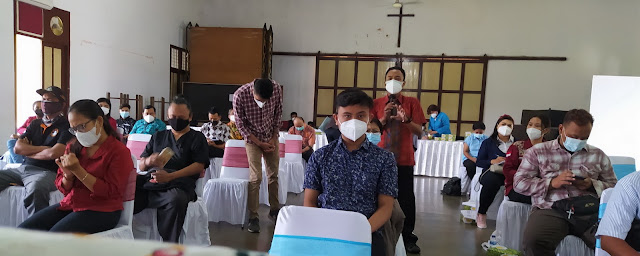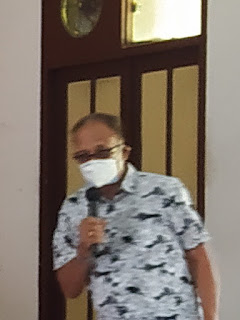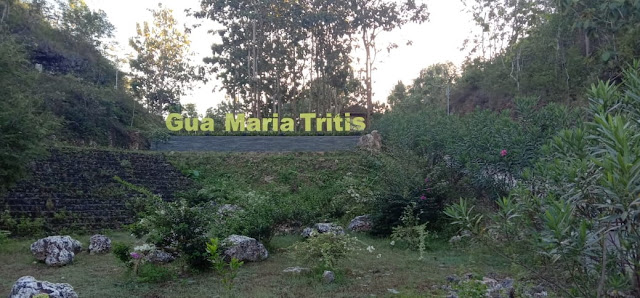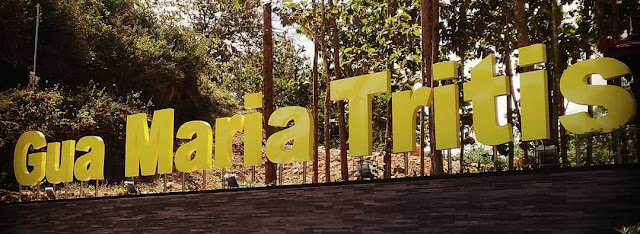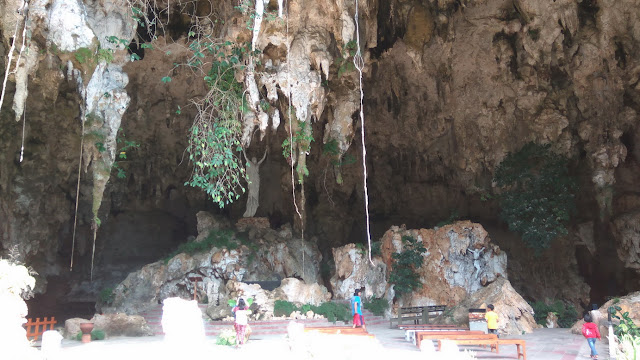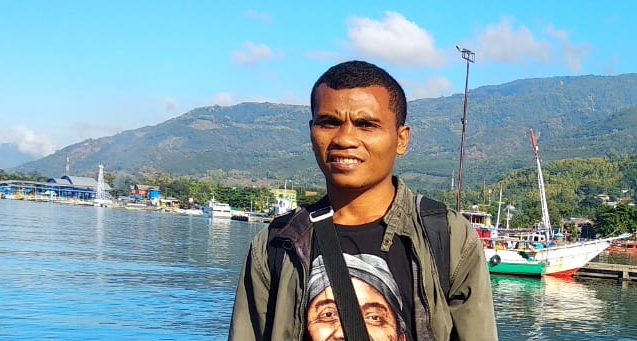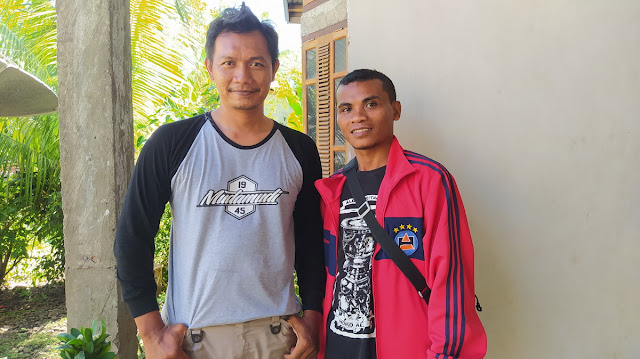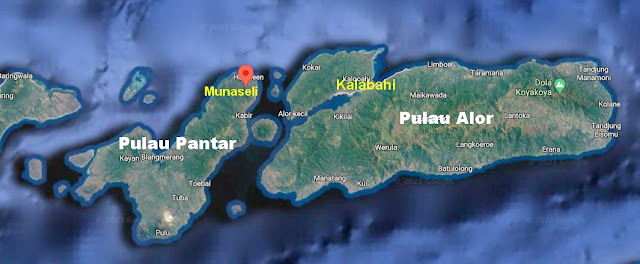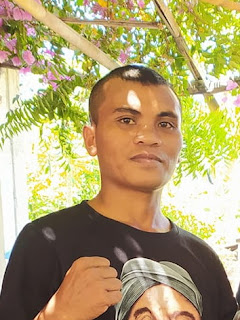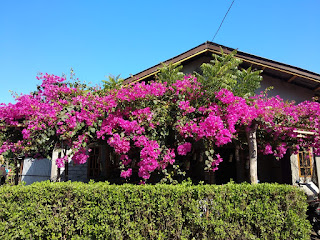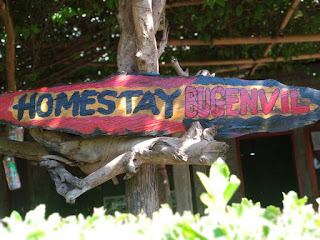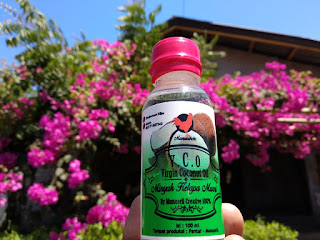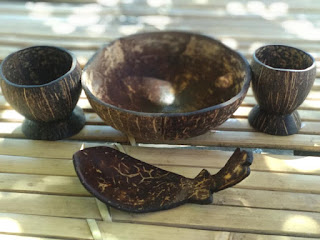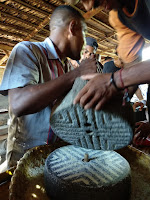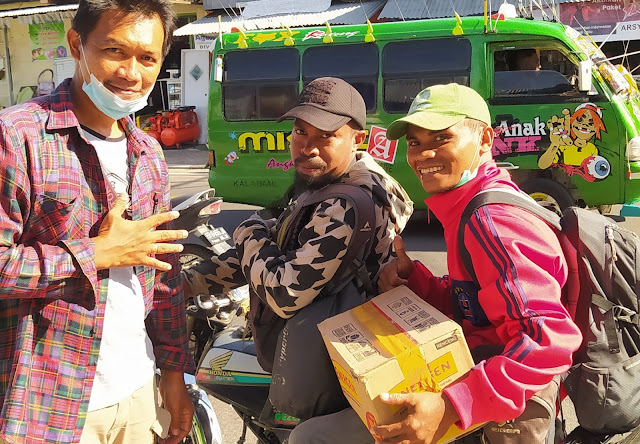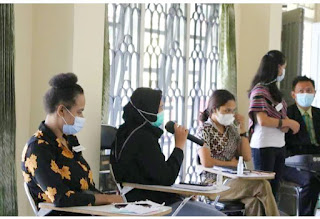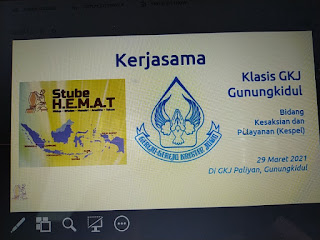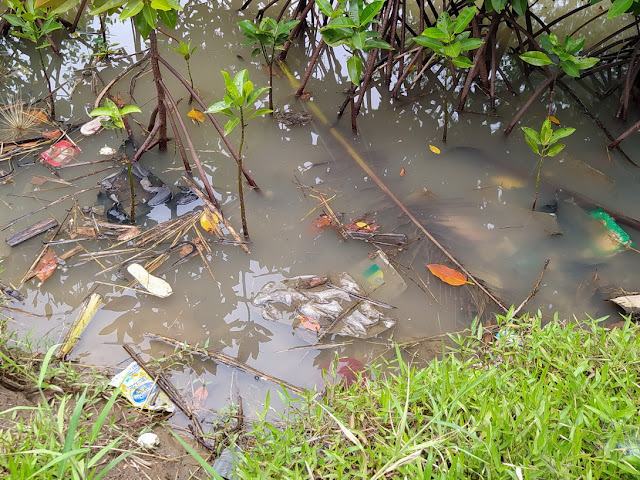Plant Trees & Preserve Water Catchment Area (Exposure to Resan Community, Gunungkidul)
Tuesday, 21 December 2021by Trustha Rembaka, S.Th.
Vulnerability of Water Supply in Nias
Thursday, 9 December 2021by Arviani Zalukhu
One important thing that must be owned by young people is sensitivity to the problems around them. There are various ways to get to know the surrounding problems, one of which is by participating in activities that introduce young people to social issues around. I discovered it when I know Stube HEMAT Yogyakarta, a place for students to observe their surroundings. There are various activities to reveal the reality that I did not realize before, such as the Water Security program. By participating several activities, I realized the importance of water covering of the quality, availability, and other standard related to healthy water.
I am Arviani Benedicta Zalukhu, from North Nias, North Sumatera, a student of Governance Science at STPMD APMD. Nias island is one of the islands on the west side of Sumatra which is rich with stories about culture, customs, and the uniqueness of nature and its people. The natural beauty of Nias can be seen in the diversity of beach panoramas and sea waves. However, it does not mean that Nias is free from problems that threaten people’s lives. In this article, I wrote the water problem in Nias, based on one news I read with the title, "Water clogged, Director of PDAM (state company for water provision)Tirtanadi South Nias branch admits the pump engine damage."
Based on the news above, the problem that occurred in Nias was the difficulty of the people in getting clean water because the water supply from the PDAM was clogged, especially in the South Nias area due to damaged water pumps, pipes leakages, and limited capacity of water storage. The main problem is only one pump unit operates of four pump units available. So, when a problem in water distribution occurs, it disrupts people's life. Like the problems in South Nias, the people faced water crises for their daily needs, they found difficulties to access clean water for drinking and other needs.
Every problem has its solution. The shortage of water supply capacity can be solved by extending water storage and increasing human resources for maintaining the equipment. It must be admitted that the government has development priorities for more urgent things or have a direct impact to the community, for example, road construction sometimes damages the water pipes or water leakage from the old ones. Apart from PDAM, the community can take advantage of existing resources, for example, rainwater. When rainwater is collected, the community can consume the water by doing filtration and electrolysis,
I had new experience and understanding after I participated in the Stube HEMAT Yogyakarta activity inviting students to learn about the wastewater treatment plant, the river water treatment plant that convert river water into drinking water, and the water treatment plant owned by PDAM Yogyakarta City. Young friends, let’s start caring your the surrounding social problems. ***
Much Efforts to Search for Water in Dry Season
Tuesday, 7 December 2021by Patrisia Jabur
By Patrisia Jabur.
Honestly, now I become more aware of the reality of water problems. At first, I knew about water issues but just a little. This concern grew when I participated in the Stube HEMAT Yogyakarta activity which encouraged the participants, including me, to look back all problems related with water, especially in my hometown. I am Patrisia Oktaviani Jabur from the island of Flores, East Nusa Tenggara province, precisely in the East Manggarai regency. I am studying at the College of Village Community Development 'APMD' Yogyakarta, majoring in Communication Studies.
The article about water problem often occurs everywhere, even in remote areas in Indonesia, one of which is in Ranakolong area, East Manggarai. I found a news with the title “Clean Water Crisis, there is a 'Cans Parade in Ranakolong, East Manggarai” at https://ekorantt.com/2019/11/23/krisis-air-bersih--ada-parade-jerigen-di -ranakolong-manggarai-timur/. This news informed that one of the most common problems experienced by the residents of East Manggarai, especially the residents of Ranakolong Village, is a crisis or lack of clean water. It happened frequently, and even worse during the dry season, the water debit will decrease. During the dry season, the residents have to collect as many water reservoirs as cans to draw water in places that provide water or water sources. To get water, the people must also collect water for daily needs and long-term supplies.
As a resident of a neighboring regency, I have observed that the availability of water in this area could be sufficient if the people there did not cut down trees indiscriminately which resulted in reduced water sources and drought. On the other hand, the government should pay attention to the community in terms of water availability. Based on the news above, I responded that it is normal for the people in Ranakolong Village to complain about water because it is now very difficult to obtain clean water, especially with the limited understanding of the community regarding the process of managing and providing clean water itself, in addition to the slow response of the competent parties in dealing with the problem, faulty pipes or reservoirs.
From this situation, I understand that, first, it is necessary to increase public awareness so that they no longer have forests or trees cut down carelessly because the presence of trees is the main condition for collecting water or springs. Second, the community needs to get socialization the importance of replanting forests that have been cut down, and third, the government must contribute to the availability of water in the Ranakolong Village area by initiating planting trees or preparing a sufficient water reservoir to meet the residents' water needs to avoid water crisis during the dry season.
Awareness about the reality of clean water problems that may occur anywhere, including the area where I come from. Awareness of a problem does not come automatically but needs a lighter to foster awareness that connects a person to the existing social reality and encourages someone to participate in paying attention to their environment. Thank you Stube HEMAT for opening my eyes to see the reality of the water problem.
The Challenges of Drinking Water Service in Yogyakarta
Friday, 19 November 2021by Kresensia Risna Efrieno
Exposure to Bedog Water Treatment Plant (IPA) of Drinking Water Company in Yogyakarta Municipality
By: Kresensia Risna Efrieno.
Water is a basic human need, but the water availability does not meet the people’s needs because of some reasons, such as, the quality and far location of water sources from the settlements. Thus, water treatment and distribution systems are needed to provide and distribute decent water to every house in need. These activities are related to process and distribution managed by the Regional Drinking Water Company (PDAM) called PDAM Tirtamarta in Yogyakarta. How does PDAM Yogyakarta manage this drinking water? Where does it come from and what are the challenges it faces? These questions made the students of Stube HEMAT Yogyakarta curious to take a closer look at how water treatment is like and where the water source used by PDAM Tirtamarta Yogyakarta comes from. The exposure to PDAM Tirtamarta Yogyakarta is part of the Water Security training done by Stube HEMAT Yogyakarta followed by dozens of students from various regions in Indonesia who are currently studying in Yogyakarta (Thursday, 18/11/2021).
The participants visited the Bedog Drinking Water Treatment Plant (IPA) located in Trihanggo, Gamping district. Here, Robid Lokananta, the head of the Bedog IPA Production Office, explained the history of PDAM Yogyakarta, which had been established in 1918, which formerly was managed by the Dutch government. Until now PDAM Tirtamarta Yogyakarta has 6 (six) Water Treatment Plants (IPA): Padasan, Gemawang, Karanggayam, Bedog, Pengok and Kotagede. He further explained, the customers reach thirty thousand connections, consisting of households, offices, and hotels. “Our customers are not only the residents in Yogyakarta but also customers in Sleman and Bantul regency because at that time there was no drinking water company in each regency. Now, we no longer open customers’ registration outside of Yogyakarta municipality because PDAMs are available in every regency,” he said.
In the water treatment process, raw water sources obtained from groundwater include springs, shallow wells, and deep wells as many as 58 units. The processing begins with a sedimentation process to settle sand and mud, aeration to increase oxygen in the water, filtration using activated lime, quartz sand, and gravel, then enters the reservoir. Before the water is distributed to customers, there is a dosing process or the chemical process to purify the water and kill bacteria in the water. The participants observed the water treatment plant directly from the well that flows into the sedimentation tank, through the aeration tank, to the water filtration installation, and enters the reservoir before being sent to the customer.
This exposure revealed the challenges faced by PDAM Tirtamarta, Yogyakarta. It is acknowledged that PDAM services are still far from ideal for making ready-to-drink drinking water due to various obstacles, including the age of old and new pipes, various pipe materials such as iron, concrete, fiber, and plastic which affect the water quality. Even It is revealed that there are some leaks in the distribution pipe reaching 50%. It does not mean that there are no efforts to solve the problems, but it is not easy, because of difficulties in detecting leaks of old pipes at the depth of more than 2 meters. In the future, the distribution pipes will gradually be replaced with HDPE plastic pipes to make them more elastic, rusty proof, less leakage and less metal elements. Another challenge faced is the decrease of water discharge in the wells due to the direct impact of massive residential, office, and hotel development without considering the water ecology in the catchment area. During the pandemic, there was also a decrease in income due to the decreasing water consumption by hotel customers.
During the exposure, students seemed enthusiastic to express their opinion that water treatment in PDAM is not as easy as it seems to be as written above. Some participants also admitted that they had learned something new because they had only heard explanations and read about water treatment so far. Now, the experiences equipped them as a provision to understand the water security problem. Students should take part to think and to act for water conservation, maintain its quality and distribution to the community fairly.
Water, Care Now, or Lose Later (Water Security Program Exposure)
Friday, 12 November 2021by Trustha Rembaka
By: Trustha Rembaka.
The slogan above welcomes everyone who enters the Regional Drinking Water Supply System for Yogyakarta-Sleman-Bantul (SPAM Regional Kartamantul) in Klangon, Argosari, Sedayu, Bantul. The words above remind people to rethink the existence of water and an invitation to act as a form of concern for water to anticipate water loss or damage in the future. The Kartamantul Regional SPAM became the destination for exposure or study visits for Stube HEMAT Yogyakarta students in the Water Security program on Thursday, November 11, 2021. Here, the students observed the installation and learned the process of drinking water treatment that’s supplied from the Progo river for drinking water company (PDAM) Yogyakarta municipality, Sleman regency, and Bantul regency.
The head of the production at SPAM Bantar, Bayu Winarno expressed his appreciation because the students have an interest in water and management. Furthermore, he explained that the installation is part of the president's strategic project to provide clean water and utilize surface water. Currently, the installation is managed by the Regional Clean Water Company (PDAB) Tirtatama in the Special Region of Yogyakarta as a provider of clean water for PDAM Kota Yogyakarta, Sleman, and Bantul since 2020. The installation here is complete because it has the process from intake, pre-sedimentation, dosing, coagulation, flocculation, sedimentation, filtration, and Clearwell including laboratories.
Continuing the exposure, the students went around the location with Baehaqi Avfarisqa, a production staff, to observe firsthand the water treatment process from the intake stage from the Progo river with a capacity of 400 liters/sec, which is pumped up through a pipe to a pre-sedimentation installation in the form of a garbage filter and deposition of sand and stone. Next is the coagulation and flocculation process, where the water is stirred and added chemicals to bind the mud particles, purify the water and kill bacteria using certain materials. The mud particles will agglomerate and become fine sediments so that the water will gradually become clear and bacteria-free. The next stage is filtration, where the water flows through a filter consisting of a layer of activated lime or zeolite, quartz sand, and gravel. Furthermore, the water enters the Clearwell or reservoir that holds clean water before being distributed through pipes to the installations of PDAM Yogyakarta, Sleman, and Bantul. From the available data, clean water from SPAM Bantar supplies water needs in 6 districts in the Sleman regency, all districts in Yogyakarta Municipality, and three districts in the Bantul regency.
The students also observed the standardization of clean water quality for SPAM Bantar. The laboratory staff revealed water indicators based on Health Ministry Regulation (Permenkes) 492 of 2010, that water can be consumed if the pH is in the range of 6-7, TDS is below 500 ppm/lt, and 0 for Ecoli and Coliform. This check is carried out twice a day internally and periodically by the public auditor.
The exposure experience opened the participants' horizons regarding water treatment, as a form of conservation for necessary deep water and preventing land subsidence caused by uncontrolled extraction of deep water. In addition, the participants also found an enrichment in understanding that in the future water has a strategic role as a means of realizing prosperity, so the management of the use of surface water needs to be developed and the strives for water not only for the availability but also for its high quality and easy accessibility for the community. Water, care now or lose later.
Reducing Problems with Sewage Management (Exposure to Balai PIALAM)
Friday, 12 November 2021by Kresensia Risna Efrieno
By: Kresensia Risna Efrieno.
Hearing the word ‘sewage' may bring negative assumptions and even antipathy, but in the reality, human life cannot be separated from waste. The Big Indonesian Dictionary defines waste as production residue, materials that have no value or value for ordinary or primary purposes in manufacturing or use, damaged or defective goods in the production process. There are several kinds of waste, from liquid, solid, and gas. The unwell-managed waste will cause disturbance or pollution. Ignoring pollution will damage the earth as a habitat for humans and other creatures into an uninhabitable place. The pollution problems range from garbage, air pollution, and water pollution. The waste problems can be managed with the 3R concept (reduce, reuse and recycle), reduce items that easily become waste, reuse, and recycle. Air pollution can be minimized by planting trees that produce oxygen, also the regulations to limit air pollution. Then, what about water that is polluted due to liquid waste, including domestic liquid waste, such as water used for washing, bathing, septic tanks, and household activities?
Stube HEMAT Yogyakarta with students are looking for answers how to treat domestic wastewater by holding exposure or field study at the Center for Wastewater and Urban Drinking Water Infrastructure Management (PIALAM) in Sewon, Bantul, Yogyakarta Special Region (Thursday, 11/11/2021). In the first part, the students received an explanation from the head of the Operations and Maintenance Section, Sudarno, that Balai PIALAM is responsible for organizing the network management and residential wastewater management system to improve centralized wastewater system services and management of drinking water network systems across regencies/municipal as well as sustainable supervision of drinking water services to regencies/municipal. He also explained the services at Balai PIALAM for Wastewater Treatment Plants (IPAL), Fecal Waste Treatment Plants (IPLT), and how the waste treatment process is carried out in three regencies/municipal, namely Yogyakarta, Sleman, and Bantul. There are two ways to distribute it to the waste treatment site, namely domestic liquid waste flowing from pipes connected to homes and processing sewage sludge which is transported using special trucks.
In the second part, the students with Heni, one of the operational staff observed the domestic wastewater treatment process, where waste flows from the inlet pipe to the pre-treatment which consists of coarse filtration, lift pump, grit chamber, and fine filter in which waste filtered and pumped to the Grit Chamber or sand deposition and through fine filtration. After that, the waste is distributed into aerobic and anaerobic settling ponds. The silt from the pond is transported to a drying pool, while the water enters the maturation pond and is added with a water purifier before being distributed into the river. Interestingly, fish is used as an indicator of the feasibility of treated water, if the fish dies it means that the exposure of waste is still strong and it applies to the opposite condition.
The fecal sewage treatment process is separated between solid waste and liquid waste using a Huber Sludge Acceptance Plant (SAP) pump. From here the waste will be sent to the waste collection point, and the liquid waste is channeled to the Sludge Separator Equipment (APLT). The sludge will be channeled into a holding tank while the wastewater will receive coagulation and flocculation treatments to reduce odors, bind sludge and purify water, including removing bacteria. From this result, it will be seen whether the water has been at the safe level or not. If not, then the process is repeated, and if it is considered safe, the water will be channeled to the IPAL installation.
The heavy rain during the activity did not dampen the enthusiasm of the exposure participants to explore every corner of PIALAM, but some students admitted that they could not persist being in that location because they were not used to the very strong smell of sewage. Through the exposure of the Water Security program, Stube HEMAT Yogyakarta brings students closer to the reality of waste that threatens the existence of water and presents new experiences and reflections, as well as raises awareness of the importance of water to emerge ideas that they can do something to minimize waste, protect water and the environment.
Let's Consume Rainwater, Will You? (Exposure program of Processing Rainwater to Drinking Water with Father V. Kirjito in Muntilan)
Sunday, 17 October 2021by Yonatan Pristiaji Nugroho
By: Yonatan Pristiaji Nugroho.
Water become the most important part of all living things. Water cannot be separated from life for any reason. The survival of living things is very dependent on the presence of water, without water the living things will extinct. Water for humans provides fluids in the body and prevents dehydration. Not only for consumption, but water is also used for daily life, such as cooking, washing, cleaning vehicles, and bathing. However, the water existence needs to be maintained in quantity and quality, access to water, and distribution for all.
The 'concern' to the existence of water needs to be maintained, Stube HEMAT in the Water Security program brings students into reality related to water problems, so that they understand and are aware, even apply in practice how to use water wisely. As a first step, Stube HEMAT Yogyakarta facilitated students to join exposure or study visit to Muntilan, Central Java to meet Father V. Kirjito and study about harvesting the Blessing of Rainwater (Saturday, 16/10/2021). Even though the students came from various study programs, such as Sociology, Engineering, Informatics, Economics, and Theology, Government Science, and Communication, they showed enthusiasm to find out how to process the blessings of rainwater.
Father V. Kirjito is known as a religious leader who has concern for water. Starting from his experience of serving the church in Bunder village, Klaten, Central Java, the village on the slopes of Mount Merapi was hit by water shortages but the rainwater had not been utilized at all. From his reflection came enlightenment to use the 'free' rainwater. Logically, rainwater that is stored directly will be cleaner than groundwater, because groundwater has been mixed with various elements in the soil, including soil pollutants. It is recognized that it is not easy to change the paradigm, but with an approach to the community and research, the habit of harvesting rainwater has finally spread. He explained the stages of harvesting rainwater by collecting the rainwater into a reservoir and depositing it. Furthermore, the water is transferred to the electrolysis installation, where the water is put into a connected container which is separated by a filter with an anode (+) in one container and a cathode (-) in the other container, then connected to a jumper according to the DC. The electrolysis process kills bacteria and there is a process of increasing pH (acidity) levels and decreasing TDS (solid content).
The students tested the pH and TDS of the drinking water they brought using a TDS meter and pH meter and then compared it with electrolyzed rainwater. Based on the Health Minister Regulation (Permenkes) 492/Menkes/Per/IV/2010 the maximum standard of Total Dissolved Solids (TDS) is 500 mg/l, and the standard pH of drinking water is 6.5 – 8.5 mg/l. They found TDS numbers in several samples, ranging from 72, 98, 117, 300, and 148. The higher the TDS, the higher the total dissolved solids is, and vice versa for safe drinking. In terms of pH, if the number is in the range of 6.5 – 8.5, it means it is safe for consumption. The participants had the opportunity to 'taste' the processed rainwater and tell about the difference 'taste' compared to the water for daily consumption.
The main point of the discussion is that students are aware of water problems, from water scarcity, difficulty to get water and the uneven distribution of water services, so that the use of rainwater for drinking water is an alternative. The rain that falls is no longer considered a nuisance and a barrier to activities, but a blessing to be independent in drinking water needs. So, are you still hesitant to drink rainwater?
Dare to Report the Sexual Violence
Thursday, 7 October 2021by Thomas Yulianto
By Thomas Yulianto
Sexual violence can happen to anyone and anyone may become the perpetrator or a victim as well, so people needs to understand what is related to sexual violence. It can even happen, someone who is a perpetrator or victim, is not aware that what he/she had got is due to a limited understanding of sexual violence. As part of enriching students' understanding, Stube HEMAT Yogyakarta held a discussion forum that presented experienced practitioners in handling cases of violence, assisting and protecting victims. With this material, the students identified what behaviors include sexual violence, how to process complaints of victims of violence to the authorities with appropriate procedures, and anticipate the sexual violence.
A discussion on Handling Violence and How to Report It held at Taru Martani (Wednesday, 06/10/2021) got a good response from students, proved by the presence of students from Nias, Lampung, Bangka Belitung, Southwest Sumba, Yogyakarta, Manggarai, and West Sulawesi who are currently studying in Yogyakarta. Ifa Aryani, S.Psi, M.Psi. as a resource person in the discussion, is a member of the Commission for the Protection of Children and Women in Indonesia (KPAI) Yogyakarta municipality. She explained the types of violence, namely 1) Physical – beating, slapping, grabbing, or any action that resulted in physical injuries, 2) Psychological – in the form of swearing, ridicule, threats, or any action that caused psychological pressure that resulted in mental and mental disorders, such as trauma, loss of self-confidence and various other consequences; 3) Sexual – in the form of rape, sexual harassment to forced sexual intercourse in marriage; 4) Economy–not providing a living for women who are housewives. Relating to Domestic Violence (KDRT) is indeed a complicated problem, but it can be anticipated in several ways, such as educating the bride and groom about the concept of the Sakinah Mawaddah Wa Rahmah (SAMAWA) family for Muslims, gender-oriented family education for each couple, and socialization of the Law on the Elimination of Domestic Violence (UU PKDRT). However, the involvement of community elements is highly expected, meaning that the community is not ignorant of the surrounding social situation.
Starting from the knowledge about gender-based violence against women, the resource person provided some other violence cases and how to report it. She explained the steps, namely by reporting to the nearest police, the Women and Children Protection unit at the Resort Police (regency level), or asking for assistance at the UPTD PPA or P2TP2A (Protection for Women and Children agency) or the service agency for reporting of victims of violence in the local area. If the victim wants to report an act of violence to the realm of law, then the complaint must be accompanied by evidence including witnesses and checked with a health institution.
It must be admitted that cultural construction in the area affects gender understanding and perspectives between men and women that affect the way how people behave. From this discussion, the students learned new knowledge about sexual violence as well as the procedures on how and what should be done by the victim, besides that, through education, the students are expected to become actors of change in understanding gender equality. The students who understand this can do socialization and education to friends, family, and people around them in various ways. Let us have courage to play a role by promoting the voice of struggle against victims of violence.
Problems Among Indonesian Migrant Workers
Sunday, 26 September 2021by Kresensia Risna Efrieno
By Kresensia Risna Efrieno
Indonesia is a very large country with a population of more than 270 million people. However, what happens if many of them suffer, are destitute, and even die because of hunger, poverty, and face injustice? Issues of injustice and violence occur everywhere including rape, murder, and even human trafficking faced by Indonesian workers. Then, what can we do? It was revealed in Stube HEMAT Yogyakarta discussion about what happened to Indonesian migrant workers abroad. An online dialogue about Peace and Justice program (Saturday, 25/09/2021) presented Erwiana Sulistyaningsih, a migrant worker who was abused by her employer in Hong Kong. Twenty of the student participants studied the reality of human trafficking and the chaos that occurred in it, while at the same time, the discussion was raising awareness of the problem.
In the discussion, Erwiana revealed several reasons why many Indonesians go abroad to work as laborers, even though Indonesia is a country rich of natural resources and other unmanaged potencies. It is assumed that they tend to be the consumers rather than producers that creates dependence and it triggers a crisis. Poverty, limited education, and unemployment are the reasons to work abroad as laborer, besides having an opportunity to go abroad even though the salary is low. On the other hand, the government opens job opportunities abroad because it increases 'state income' with the increasing number of migrant workers.
The history of population migration tells that there is a change in mindset as before 1980 the sending of workers were professional workers to Europe and the Middle East and the majority were men and there were no special rules. After 1980s, the laborers were sent to the Middle East and Asia, and the majority were women as household assistants, factory workers, plantation workers, and others. Furthermore, various regulations related to migrant workers emerged, from recruitment of workers through labor supply companies, various requirements, and even state revenue from the exchange rate for remittances of workers abroad. The data from BP2MI, in August 2021, there were 5.222 placements of Indonesian migrant workers consisting of 71% working in the informal sector and 29% working in the formal sector, with variety of educational background covering elementary, middle, and high school graduates that dominate over diplomas and universities. This is a challenge to improve the quality of the workforce to work in the formal sector.
The difficulties faced by the laborers have occurred since the beginning of recruitment, the training process before they are sent abroad, even when they arrive abroad it isn’t instantly they get good conditions or high salaries as promoted at the beginning. Erwiana herself chose to become a migrant worker because she was encouraged because of the undeveloped condition of her village, limited access to improve welfare. She applied for a job in a labor company and attended briefings and was eventually sent to Hong Kong. Unluckily, she was treated unfairly by her employer in Hong Kong, and she suffered various persecutions and tortures. Access to communicate with the company and neighbors was blocked so that she could not defend herself and her condition worsened. The employer will also run away from the responsibility by sending her back to Indonesia secretly. Arriving in Indonesia, she received help from fellow migrant workers and it went viral and became a big case in Hong Kong. The court process went on and the employer was punished and then Erwiana joined the struggle of the migrant workers. Choosing to work abroad is not a bad thing but it is not an easy thing. When someone wants to work abroad, he or she must have complete provisions such as mastery of language for communication, self-skill to work according to the field, and knowledge related to the rules of working abroad, so that cases of human trafficking can be avoided.
Let’s Indonesian youth, find your own-potency, combine it with natural resources and opportunities in your region so that there is no more unemployment but productivity to support welfare.
‘Speak Up’ – Against Sexual Violence and Human Trafficking
Sunday, 12 September 2021by Kresensia Risna Efrieno
Oleh: Kresensia Risna Efrieno.
And when we speak we are afraid,
Our word will not be heard, nor welcomed,
But when we are silent, we are still afraid,
So it is better to speak,
Remembering,
We were never meant to survive,
(Audrey Lorde, The Black Unicorn)
The poetry above opened a discussion of Stube HEMAT Yogyakarta on 'Sexual Violence and Human Trafficking' (Saturday, 9/11/2021) at Wisma Pojok Indah. Ariani Narwastujati, S.Pd., S.S., M.Pd., Executive Director of Stube HEMAT conveyed this verse as a reminder to speak out against sexual violence and human trafficking. This topic is part of the Peace and Justice program where violence against children, sexual violence, and human trafficking still occurs. Violations of children's rights in the form of pressure and sexual violence in Indonesia have soared reaching 1.192 reports according to the National Commission for Child Protection, in 2019 with several prominent cases occurring and spreading in remote areas. In addition, Indonesia is a supplier country for women workers to foreign countries so that human trafficking is vulnerable to occur. Many Indonesian women want to work abroad because of the lure of high salary, but they are recruited by illegal labor recruitment agencies without official legal protection and even trapped as victims of human trafficking, experiencing inhumane treatment, threatened with the death penalty, and ended up losing their lives.
What can students do? Stube HEMAT as a student assistance institution encourages students to be sensitive to social problems that occur around them, know what to do, and contribute ideas to reduce potential problems. Stube HEMAT Yogyakarta discussed with 20 students at Wisma Pojok Indah, Condongcatur (Saturday, 11/09/2021) by presenting competent practitioners, including Arnita E. Marbun, SH, MH, legal consultant at the Woman Crisis Center (WCC) Rifka Annisa, Rev. A. Elga J. Sarapung, (Executive Director of the Institute DIAN Interfidei) and Rev. Em. Bambang Sumbodo, S.Th., M.Min (Board in charge of Stube HEMAT).
Arnita in her presentation opened the participants' minds with the question, what do participants imagine about sexual violence and who could be the victims or perpetrators of sexual violence? This question provoked participants to recognize sexual violence that occurred in their immediate environment. Sexual violence can happen anywhere and everyone can be a victim or a perpetrator. Students must have the courage to say no to anything that is coercive and threatens humanity, and they also know what to do when sexual violence and human trafficking occur. It was revealed in this discussion that several participants had experienced sexual violence and they found the strength and courage to express it. Arnita, who has experience assisting victims of sexual violence said, “This forum is an open forum to strengthen and support one another. So when someone wants to 'share' they can help each other. Give a sense of security and empathy, support the victim, then help collect evidence and find competent people and institutions to handle cases.” Young people need to have provisions to take care of themselves and to help others maintain their dignity in life.
Rev. Elga Sarapung, a priestess serving in ministry and interfaith in various parts of Indonesia, revealed the fact that she frequently faced the reality of human trafficking cases in Indonesia. The cases are still very high and not easily resolved due to various triggers and interrelated situations. Poverty, lack of access to education and information, weak law enforcement, local customary culture, gender inequality, and limited labor recruitment are the triggers. A documentary video was played and visualized the story of a priestess and nuns in Kupang, East Nusa Tenggara who often handle cargo containing bodies of victims of human trafficking who are sometimes not recognized when it arrived home in the area due to fake identities. She emphasized that trafficking is a serious humanitarian issue and religions must care for humanity and defend life in a dignified manner. Young students needed to build networks, both local and international related to the issue, be critical of existing cases and reduce opportunities for human trafficking.
Rev. Bambang Sumbodo at the end of the discussion reminded the importance of sexual education from the closest environment, namely the family to understand sexual violence. Regarding human trafficking, education and awareness are important to the community, from the immediate environment, about the dangers of human trafficking. Students from various regions in Indonesia must be sensitive to the surrounding environment and contribute by educating the community. From this point, it is time for students not to be silent and ignore the reality of sexual violence and human trafficking, but to be sensitive to the reality, brave to say no to violence, and dare to speak out against sexual violence and human trafficking.
Promoting Children's Rights Through Video
Tuesday, 31 August 2021by Kresensia Risna Efrieno
By: Kresensia Risna Efrieno.
Have you ever found a problem in your place of origin? Have you ever thought about expressing your concern about it? Or documenting it on video? Nowadays, videos are highly liked to be studied and video-making skills are liked among young people, especially students amid technological advances. The combination of technological advances and revealing reality has become Stube HEMAT Yogyakarta's strategy in the Peace and Justice Program to hold short video competitions for students throughout Indonesia. This competition is not just about telling events or data into an interesting video-shaped work but encouraging students to recognize children's rights, the reality of the problems faced by children in their respective regions.
This short video competition starts from 6/08/2021 until two weeks for participants to work on videos. Twenty student participants from various study programs and various regions in Indonesia took part in this competition. This activity is also one of the challenges for the Stube HEMAT Yogyakarta team to recruit participants and provide assistance during the PPKM period. However, this is not an obstacle, the team and participants continue to assist online. The participants who took part in the competition started the competition process by studying together with the Stube HEMAT Yogyakarta team as a companion to understand Children's Rights, then mapped out problems related to the implementation of children's rights in their area. From these findings, they explored why it happened and what alternatives to overcome these problems. Then, they designed a narrative and made it in the form of video recordings, either in the form of reports, narratives to short films containing creative and in-depth messages to promote children's rights in Indonesia.
At the end of the deadline, nineteen videos reveal the reality of the problems faced by children in various regions in Indonesia, including from Manggarai, Alor, Sumba, Nias, Humbang Hasundutan (North Sumatra), Gunungkidul, Sukoharjo, West Sulawesi, and East Lampung. The video making required struggles because the participants have to map the situation in their area, analyze, design scenes and record to edit videos, even they have to overcome the limited communication networks. However, they completed the video according to their capabilities.
Considering an objective assessment, Stube HEMAT Yogyakarta involved practitioners who are competent in their fields as juries, including Ifa Aryani (Indonesian Child Protection Commission (KPAI) for the city of Yogyakarta), Bandel Ilyas (actor, director, casting director), and Richard Panggabean (multimedia, recordings, and audio-visuals). Based on the content, artistic, and appearance aspects, the top five videos emerged, namely, 'Why should I?' by Jakson Hamba Tana from East Sumba as first place; “Have My Rights Been Fulfilled?” by Merlince Pauline Maure from Alor as second place; “Mama, I Want to Go to School” by Angelina Delviani from West Manggarai as third place; “Why Am I Getting Married?” by Thomas Yulianto from East Lampung as fourth place and "Don't Leave Me" by Eufemia Sarina from Manggarai as fifth place.
From the juries' response, it was revealed that they appreciated the efforts of the participants to reveal the reality of the problems faced by children in their hometown. However, the participants must continue to improve the quality of the video, starting from formulating ideas, compiling narratives, taking pictures and transitions, sound volume, using pictures that are part of the video. Young students need not to be afraid to express themselves. Starting to sharpen sensitivity to see reality, be creative in utilizing technological advances, and dare to voice the call of humanity, especially children's rights amid civilization.
Young Generation Ono Niha is Exploring the Children’s Rights
Wednesday, 18 August 2021by Putri NV Laoli.
By Putri NV Laoli.
As part of the younger generation of Ono Niha, Nias, North Sumatra, and have learned the children’s rights, I invited the young Ono Niha to have online discussion about children's rights to Commemorate the Republic of Indonesia's 76th independence (18/8/2021). The initiative got responses from young people, from students, high school graduates, and those who are employed. Understanding about human rights, especially important children's rights, is important because of human rights that cannot be revoked. Life is a fundamental right that humans are born with and starts from the freedom of children to their rights.
Starting the discussion, Franciscus Harefa, a youth figure in the community of Ono Niha, said the stepping point of the discussion: "the purpose of this discussion is to establish a relation, as well as a media for online discussion to reach young Nias and sow a habit for discussion. So the youth will have new insight and knowledge and concern for the environment."
Then I introduced the concept of 'child's rights, the idea of children rights appeared at the end of the First World War and continued after the Second World War as a reaction to the suffering that occur after the wars, especially faced by women and children. The struggle for the rights of the child was marked by Eglante Jebb in 1923 through the Declaration of Children’s Rights that have 10 point statements Rights of the Child. It was adopted by the League of Nations and known by the Geneva Declaration and then the General Assembly of the UN finally adopted it. While in Indonesia, the concern for children began since the founding of the Indonesian Women’s Congress in 1946. Then in 1951 Indonesia Woman Corps (Kowani) held a congress, and established a National Childhood Day. This led to the start of the National Child's day on July 23 through The President Decision 44/1984 and on September 5, 1990, the Government ratified the Convention on the rights of the child through The President Decision no 36/1990.
As time goes by, the appreciation to the rights of the child grows but, unfortunately, many people have not been 'aware’ of the issue which led to violence against children who should be protected, children who should be educated and have been dropouts, children work hard with have no time to play, recreation and to get sick because of bad habit, food, and unlivable home. Then, who is responsible for fulfilling the child's rights? Answering this certainly begins with who is in the closest circle of children, like parents, families, local communities including the local government to the central.
This discussion was so interesting when the participants gave their responses, Ilham Trihayono a management student of Sultan Ageng Tirtayasa University told his experience with a 7-year-old suffering from illness PDD-NOS, a type of autism. "Children with autism often get bullied, and sometimes get no 100% protection because of bullying at school, so parents tended to be protective by forbidding he/she to play." On the other hand, Andre one of the participants criticized that the real target of information on the rights of this child, a person over 18 years old, a parent, or a government, and whether the rights of the child should be deprived? If a child knew the rights he or she would become more difficult to manage.
To be sure, the adults should know the rights of the child and implement it as their responsibility to establish child welfare. It looks simple but will impact the life of a generation, especially to a better Ono Niha generation.
Giving More Insights of Young Nias about The Children’s Rights
Sunday, 8 August 2021by Putri NV. Laoli.
By: Putri NV. Laoli.
Have you thought about the term of a child? In various literatures, children are models of adults. Just as adults demand that their rights should be fulfilled, so the children have rights to be fulfilled even though they are not aware of it. The adults should ensure that the rights of the child are fulfilled and they are protected from the violence that threatens them. I discovered the reality from Stube HEMAT Yogyakarta's discussion about "The Children’s Problem in Indonesia and Striving for the Rights of the Children" (5-6/8/2021).
From the discussion, I was curious to find information by observing the environment that related to the rights of the children. The Ministry of Women's Empowerment and Child Protection (PPPA) noted 5.463 cases of child abuse until July 2021. Based on the data from the ministry of PPPA's online information system for Women and Children's Protection, the majority of child abuse cases occurred in households. While others take place at schools and public places. The kind of violence covered physical, psychic, displacement, trafficking, and exploitation even sexual violence. The violence affects children of various ages, while reported cases are common in high school/equals.
One of the causes of the cases is minimum understanding and awareness of the rights of the child among adults, so it needs efforts for socialization among the society. I took a simple step to promote an understanding of the rights of the child, especially in my hometown, Nias, although I am currently in Yogyakarta. I encouraged my sibling, Kefas Charity Laoli, to talk with local youths. Although he is still at high school, he responded positively and vigorously moved local youths to learn the rights of children in Nias through online meeting (07/08/2021), held in the community center of the Gido District, Nias Regency, North Sumatra. At least eight youths from various schools joined it.
I started the session with a simple game as ice-breaking and helped participants easily understand the topic. Then they looked at a brief history about the emergence rights of child concept at both international and national levels, the diversity of rights of children, and those who are responsible to ensure those rights are fulfilled, including parents, families, communities, and governments. At the end of the discussion, I invited them to map the children's rights implementation among themselves by checking the statements that have been shared. Then, they came to realize and recognize that some things remain unfulfilled from the 42 rights of children according to international conventions. From this phase, I ignited them to reflect on what causes the rights of children to be unfulfilled and what can they do as teenagers? Until one understanding came up that youth should actively participate in the child community of their area as a means to campaign for the children’s rights both in the family and in the community, including balancing the rights and duty of the child.
The process of the activity made me more convinced that children need an adult's touch to introduce their rights since early age. One of the participants, Sri Zebua gave feedback, "Through this activity, I learned my rights and obligations as a child either in the family-community, or the government." Another participant, Cici Halawa said, "I didn't realize that there were children's rights until I found out that I had learned a new topic besides school subjects in this activity."
One simple action that touched the grassroots will awaken consciousness and enthusiasm to life. The adults and governments work together to realize a child's rights and create children growing environment and space that are conducive, safe, and away from violence.
Revealing Reality Through Video
Saturday, 7 August 2021by Yonatan Pristiaji Nugroho
By: Yonatan Pristiaji Nugroho
Video is a technology that displays sound and moving images to convey a message. Through video, messages can be in the form of news or events based on facts or stories that can educate and provide information. Video creations can be displayed in several forms, such as TV channels, Movies, Youtube, Instagram, or Tiktok. Each video presented has its specific goal and purpose.
The “Peace and Justice” program done by Stube HEMAT encouraged participants to see and understand peace and justice, especially violence against children, human trafficking, and sexual violence that occurs. Furthermore, Stube HEMAT Yogyakarta provided them an opportunity to participate in a discussion (Friday, 6/8/2021) with the topic of the program “Peace and Justice” in the form of a video. This discussion which was followed not only by students living in Yogyakarta but also from outside the island, such as Alor NTT, Manggarai NTT, Sumba, and Kupang trained them to develop video-making techniques. The discussion was conducted online due to government's regulation during the pandemic.
In collaboration with Bandel Ilyas, a film practitioner, an actor (theater and film), director, and a casting director on various films and other works, such as a short movie entitled Rumah Pohon, Unbaedah, Pulang Tanpa Alamat, Segawon, or film entitled Filosofi Kopi, Demi Waktu, Bumi dan Manusia, and Mantuk which he directed. In this discussion, he revealed the process of making films/videos. What should be considered in making a video? Such as determining the theme and concept of the video, writing the film statement as an idea for scriptwriting, making a shooting schedule for the shooting schedule and shooting list to record what events will be obtained, then editing the script as a framework for the film/video to be made. These steps are very important to combine raw video into a unified visual image having a message and purpose. The message conveyed by each video is specifically based on the type, such as comedy, education, documentary, or fiction video.
In conversation with resource persons, the participants asked many questions about making videos and some participants even had never made creative videos at all. One question from Isna, a participant, "Can the data be added to strengthen the dramatization?" He responded that like in a reality show, a documentary video could be dramatized by the narration and the narrator. Dramatic value is the totality of the journey and conveying the plot and message of the film to the audience. The power of narration and narrator is very influential on dramatization. Another participant, Rivaldo also asked how to show personal experience in the video. Ilyas explained that for a personal experience, the aspect of objectivity should be expressed more rather than subjectiveness, where the scripts should come from factual events.
Through the discussion, the participants are expected to learn in making creative and beneficial videos for the audience. They are motivated to make their video creations, both from personal experience and concepts made before. A good video provides education and a message for the viewer. Positive messages lead not to bring down and offend other parties or people.
Stube HEMAT Yogyakarta invited the participants to participate in the short video competition about Children's Rights and the reality faced by children in Indonesia. Keep on sharpening awareness to see social realities and reveal them in videos. Come on, students are capable!
Exploring the Children’s Right and the Challenges in Indonesia
Friday, 6 August 2021by Thomas Yulianto
By: Thomas Yulianto
According to the Ministry of PPPA (Woman Empowerment & Child Protection), the number of violence against children in Indonesia in 2021 is high, reaching 3.122 cases, and most of them are sexual violence. Its high number of violence against children became the stepping point for Stube HEMAT Yogyakarta to discuss with a theme "Mapping Children's Problems in Indonesia and Promoting Children's Rights." The discussion was held online (Thursday, 5/8/2021) and was attended by students from various regions, Nias, Medan, Bangka Belitung, Lampung, Java, Sumba, Manggarai, Alor, Maluku, and Raja Ampat.
Ariani Narwastujati, S.Pd., S.S., M.Pd., the Executive Director of Stube-HEMAT was the training resource person. She has experience in international training on Children's Rights at Stube Nord, Hamburg, Germany. In the discussion, she asked the participants about what they would fight for regarding the children's rights? Most responses focused on the rights of education and protection. The level of education rate in the village is lower than in the city, due to low understanding of children's rights among parents, such as getting a 9-years-minumum education. In some participants’ areas, the violence against children occurred because of the habits of the parents as the example from one generation to other generation, so that the rights to protect children need to be fought for.
Ariani presented the International Convention on the Rights of the Child, which began in 1989 when the world's governments gathered and made a policy to protect children by the international legal framework of the United Nations. Children need care while growing, learning, playing, developing, and to be treated fairly. There are 42 points in the children’s right in the convention and they are ratified into 10 point of children's rights in Indonesia. They include the rights to a name or identity, protection, have citizenship, food, health, recreation, education, play, participation in development, and equality. The rights to child protection in Indonesia itself are regulated in the Law of the Republic of Indonesia, No. 23 of 2002.
After receiving material on the International Convention on the Rights of Child and children's rights in Indonesia, the participants are well informed with children's rights. It could be heard from the feedbacks of the participants' experiences that occurred in various regions in Indonesia showing children who suffered from physical violence when they were assumed to be disobedient, ignorance by busy working parents, unhealthy home environment because of the smoking parents, and traditional needs are prioritized over providing children's educational needs. From the findings of these cases, the participants learned that children's rights had not been fully fulfilled and discovered that not everyone understood children's rights. The understanding and awareness of children's rights were important for adult in the child's environment to provide space for children's growth and development and learning. These various incidents may be caused by the low knowledge and awareness of children's rights besides the influence of life habits, education level, and culture. It is expected in the future that through intense education and socialization to the community about children's rights, there will be better understanding and realization of children’s rights.
Through the discussion, the participants were challenged to involve themselves as agents of change, to fight for children who have not yet get their rights in their childhood. They are motivated to implement children's rights when they become parents somedays. Long live Indonesian children!
Expressing Experiences Through Writing
Wednesday, 30 June 2021by Daniel Prasdika
By: Daniel Prasdika.
The Multiplication Program of Stube HEMAT in Lampung has been running for one year. During that period, various activities have been carried out to equip young people, especially at Pondok Diakonia, GKSBS Batanghari, East Lampung, under the guidance of Rev. Theofilus Agus Rohadi, S.Th, as the multiplicator. Starting from the topic of Piil Pesenggiri, religious diversity, and vulnerability in Lampung and the Lampung potencies that can be developed, this one-year process is interesting to explore how the existing experiences are felt by multiplicator and the young people.
The process of expressing experiences, especially through writing, requires special skills, so that the writings become interesting to read and easy to understand, so it is important to provide writing assistance to young people in the scope of services at Pondok Diakonia. With the initiative of Daniel Prasdika and Thomas Yulianto, Stube HEMAT activists in Yogyakarta, and having experience to love in Pondok Diakonia, they held virtual sharing and talks as motivational encouragement to write with the Multiplicator of Stube HEMAT in Lampung, Rev. Theofilus Agus Rohadi, S.Th and the students of Pondok Diakonia and the surrounding young people on Tuesday, June 29, 2021
Twelve participants attended the online discussion. It motivated them to practice writing and produce written works to express experiences and reflections of the activities participated in Stube HEMAT. Dika and Thomas started sharing by introducing themselves that have ever lived in Pondok Diakonia and while studying in Yogyakarta, they are active at Stube HEMAT Yogyakarta. Writing may be considered ‘simple’ but the impact is extraordinary. Written works convey information, knowledge, and even motivation to many people and indirectly save memories. Writing is an easy thing if there is a will, willing to learn, and it is used to write. Furthermore, several participants expressed interesting experiences when participating Stube HEMAT program in Lampung, such as getting a new understanding of moral messages from Piil Pesenggiri, visiting Lampung traditional houses, having a dialogue with other religious leaders for the first time, and realizing the potencies of both conflict and abundant natural to support the economy in Lampung.
Trustha Rembaka, S.Th., the coordinator of Stube HEMAT Yogyakarta conveyed the basics of writing as a combination of knowledge, skills, and will. These three things underlie someone to write. Writing itself is a real expression of what is seen, heard, and felt in written form. The text structure that can be used is the 5W+1H formula, namely when, where, what, who, why, and how. With the help of this formula, short writing can be built by stringing words together in each paragraph. Moving on from this, the young people in Lampung will be able to produce writing works.
At the end of the dialogue, the participants determined that all the impressions of their participation following Stube HEMAT Lampung activity would be transferred into writings. Writings of expressions of experience help others to learn, open up insights, get inspired, or even generate strength. So, are you still putting off writing and not sharing your experiences? ***
Keep the Health Protocols and Do Solidarity
Saturday, 26 June 2021by Thomas Yulianto
(A seminar held by PGIW DIY on Covid 19 Handling Management)
By: Thomas Yulianto
Since the beginning of 2020, Covid-19 has not ended until now in 2021. There are new types of Covid-19 variants that hit Indonesia, namely Alpha and Delta, which have spread in the Special Region of Yogyakarta. This new virus variant has more severe symptoms than the previous one. People exposed to the new type of virus will get a fever, shortness of breath, dry cough to fatal if it is not handled correctly. Regarding to the virus as an infectious disease, it is necessary to deal with the spread of the virus quickly and immediately. It is unfortunate when the new variant of the virus has infected many people, but the people are reluctant to work together to fight the spread of the virus. Perhaps the people are bored in applying health protocols to stop the spread of the new variant of the Covid-19 virus.
From the data, the Covid 19 cases increase, it was recorded that in the last week of June 2021, more than 20.000 people were exposed only in a day (20.574 cases per June 24, 2021), so it needs serious attention. As part of efforts to strengthen the community in dealing with the pandemic, the Regional Association of Indonesian Churches (PGIW) of the Special Region of Yogyakarta initiated a Seminar and Management Training for Handling Covid-19 and Natural Disaster Problems at Wisma Immanuel, Samirono, Depok district, Sleman regency on Friday, June 25, 2021, by inviting representatives of churches in DIY and community institutions including student organizations.
Related to the topic, PGIW DIY invited resource persons in the handling of Covid-19 and Natural Disasters, such as Covid19 Handling Task Force of Depok district, who is also the Depok district Secretary, Wakhid Basroni, S.IP. M.Sc. He revealed the handling of the pandemic in the Depok district was unable to accommodate all needs due to limited personnel, thus requiring the cooperation of various parties, government officials, health workers, and the community themselves to be disciplined in applying health protocols. He also emphasized that self-awareness is the main key. The head of the Health Promotion section of the Depok District Health Center, Aditya Sejati S.K.M, M.K.M., explained that the virus will continue to mutate so the keys to anticipate the spread of the new variant are the people must keep the existing health procedures including checking the availability of clean water, periodic disinfectants, quality masks, and temperature checks. Regarding the disasters topic, Suparlan from the Sheep Indonesia Foundation revealed that Covid is a disaster and it is classified as a non-natural disaster, namely disease outbreaks. Two steps can be done, namely disaster management to deal with the virus and disaster risk reduction with applying health protocols and vaccination. Vaccination is the government's responsibility and should be supported. The vaccination program was received by the community, but some were still doubtful. Some refused it, some others wanted a vaccine but had difficulty accessing the information.
From this seminar, there was a discussion about boarding students who were exposed to Covid-19 and asked to leave by the boarding house owner to avoid the infection to others. However, it is not easy for the boarding students to leave immediately and this must get attention, whether the boarding house owner's actions are appropriate and what should be done? The government provided shelter facilities for people exposed to Covid-19 for self-isolation and provided the needs of meals three times a day, as well as vitamins. However, this information has not been widely informed. More socialization is needed regarding the facilities provided to people exposed to Covid-19 and the surrounding community so that there is no disinformation between the community and the government.
At the end of the seminar, the Chairperson of PGIW DIY, Rev. Em. Bambang Sumbodo, S.Th., M.Min., said that churches and community empowerment institutions could not remain silent but provide socialization. The church needs to be calm in dealing with the spread of Covid-19, but also eager to do the action because the pandemic situation hit not only physically but also psychologically. The church should come, greet, accompany and present even though virtually or by video call. The church must move and be brave to be busy and dare to work hard.
Now, we need to move with a new spirit to help each other and pay attention to others who are sick, exposed, or isolated, while keep to have self-awareness to apply health protocols. Let's move to protect ourselves and others and to respond to the call for humanitarian solidarity.***
Be Harmonious in Maintaining the Livelihood (The Form of Economic Democracy for the Communities Around the Cave of St. Mary, Tritis)
Saturday, 19 June 2021by Yonatan Pristiaji Nugroho.
By: Yonatan Pristiaji Nugroho.
In the southern part of the Special Region of Yogyakarta, there is a Catholic religious tourist spot called Gua Maria Tritis (The cave of St. Mary, Tritis), located in Bulu, Giring village, Paliyan district, Gunungkidul regency. The cave is closely related to a historical figure, Ki Ageng Giring, a famous figure in the period of the collapse of the Pajang kingdom and the establishment of the Mataram kingdom, who is said to meditate in the cave.
The existence of the tourist spot opens widely for employment and business opportunities for the residents. This is shown by several residents around the cave who work and serve in the cave of St. Mary. Further, to determine who is in charge and working in the area, the village apparatus held a deliberation meeting with the residents at the village hall. It was attended by the representatives of the Head of the Family and the village head and parties from the Wonosari Parish church to determine some job opportunities, such as parking lot, cleaning staff, and selling food and clothes, meanwhile, the person in charge of the entrance is from the parish church of St. Petrus Kanisius Wonosari as the owner of the area.
Democracy is not only related to politics but also social, cultural, and economic. Politics is not far from the rights of each voice to determine political activity in their regions. In socio-cultural, democracy is aimed for social welfare and justice. As in the economy, every individual has the right to get job opportunities to achieve a good standard of living. Democracy in all these fields is interconnected with one another, it cannot only in politics but in social and economic implemented among society. Likewise, with the community around the cave Mary, Tritis, everyone has the right to get a job and to create an independent business, both from the natural products around the cave and the residents’ creativity.
Diversity is seen in the community as a form of tolerance. Everyone working there has various backgrounds of their origin, religion, culture, and gender. Everyone has the right to work there though that is originally a place pilgrimage for Catholics. Not only that, but the residents also maintain the tradition by working together in the cave area or called mutual work to keep the cleanliness of the cave area.
So, is it important to implement democracy in society? Of course, without democracy, we cannot carry out our obligations and get our rights as a society to get justice, political right, socio-cultural, and economic needs. People are free to involve themselves in political, social, and economic aspects. This is also obtained from the role of democracy in the community around the cave St. Mary, Tritis, the existing democracy does not tend to one party who has authority, but everyone gets justice and freedom that bring positive impact both individual and group. Tolerance in diversity must be promoted as a value of unity in the society and the nation. ***
Muku Ca Pu'u Neka Woleng Curup, Ipung Ca Tiwu Neka Woleng Impung (Sense of brotherhood in word and will)
Friday, 18 June 2021by Kresensia Risna Efrieno.
The value of local wisdom in Satar Lenda, Manggarai regency
By: Kresensia Risna Efrieno.
Observing the implementation of democracy in some regions in Indonesia is an opportunity for young people to watch deeper the real democracy. Perhaps it drives to a question, how the ideal democracy is. The scope of democracy is very broad, from political, social, and economy. Even from our daily life, it can reflect whether we are implementing democracy or not.
Ideally, democracy leads to common good, prosperity, and wellfare wherever we are without any other party being stressed or feeling difficulties. The practices of democracy in each region must be different and have their uniqueness. In East Nusa Tenggara Province, Manggarai Regency, Satar Lenda Village, the practice of democracy can be seen in daily social life. The Manggarai community has a term "Muku Ca Pu'u Neka Woleng Curup, Ipung Ca Tiwu Neka Woleng Impung" which means that the Manggarai community is one family, one descendant, must remain united to establish togetherness among differences. The local wisdom has become the motto of the Manggarai people to show their democratic practices from the past, especially social democracy.
In my opinion, the people in Satar Lenda village have unique social democracy called the working barter system or 'Dodo' in the local language. The working system is used by the village community to ease the burden of spending money when employing workers. This work system is carried out with the principle of paying labor with labor as well. So that besides being able to ease the burden, the community also creates a good and harmonious social life. This custom has been carried out by the community since the ancestors. The habit is applied not only in the work system but also in a social gathering. Commonly, in the social gathering, the people collect money, but in my village, it is a bit unique and different. The mothers there agreed to form a social gathering for pigs. Every three months one person may slaughter their pig to give to other group members in exchange for money. The habit is done to help people in need and establish good cooperation and socialization among people. These habits continue till now and are very helpful for people in rural areas who are economically disadvantaged.
A human without help from other humans is an impossibility, that is why humans are called social creatures because they need each other. Therefore, the habit above must be sustainable to support human welfare in a social environment. The youth in Satar Lenda Village as the next generation has the responsibility to maintain it. One of the solutions is the young people must maintain good relations with others, establish a youth community and discuss something related to good habits there. By holding regular discussions and sharing each other's struggles, the young people will easily cooperate in all matters, whether related to economic or social needs. Let's preserve the local cultures that bring goodness in togetherness and democracy from the things we do every day.***
Clan-Based Village Head Election (The Form of Local Democracy in Ohoirenan)
Thursday, 17 June 2021by Sarlota Wantaar, S.Pd.
By: Sarlota Wantaar, S.Pd.
Indonesia has various cultures and islands scattered throughout the archipelago, one of them is the island of Kei Besar in the south of Southeast Maluku regency. There is a village called Ohoirenan which has more than five hundred family heads. The people here have customs and cultures that have existed since their ancestors' age. The village of Ohoirenan is unique because it maintains its culture and they think that is very important to do. One of the unique cultures in Ohoirenan village is the process of the village head election.
The people in Ohoirenan village elect their village head to implement a unique democratic system because it has its custom which is different from what the government does. They use 'local wisdom' democracy that has existed since a long time ago. The village head in Ohoirenan village is chosen based on people who have bloodlines to become village heads or leaders, so not anyone can run for the candidate. The person came from one of the clans in Ohoirenan village, called the Rahallus clan, and that was not all of the Rahallus clan, but from a certain family. If there is already a candidate for the village head, then there are four clans in Ohoirenan to determine the village head, namely the Rahangmetan, Rahasomar, Wantaar, and Rahangiar clans. These four clans are represented by each clan head to determine who is entitled to become village head, this kind of democratic practice has been passed down from generation to generation until now.
In 2019, the village head election in Ohoirenan village applied a similar process to what the ancestors did as a form of local democracy in Ohoirenan village. In the election, only one person running for the candidate, namely Julius Rahallus, so that four clans decided to appoint him as village head. On October 17, 2019, he was inaugurated as village head through a customary and government process, which was attended by the regent of Southeast Maluku, Drs. Muhammad Taher Hanubun. In his speech, he said that Ohoirenan village could be an example for villages in Kei Besar, Southeast Maluku in the village head election process.
In Indonesia, each regional culture is unique because each region has its democratic customs and practices. All of them are well-maintained. This is the reason why the election of village heads is carried out in a local democratic manner as a form of maintaining and preserving the existing customs of the ancestral village of Ohoirenan. Once again, this shows that Indonesia is diverse and the diversity itself is beautiful. ***
Ruben Sonhibu, a Young Initiator from Munaseli
Wednesday, 5 May 2021by Trustha Rembaka
Developing village-based ecotourism
By Trustha Rembaka
An interesting topic at this time is discussing the role of young people in their participation to develop the village. The existence of young people who have 'heart' for their village or hometown is a blessing and should be supported, even though the struggle is not easy because there are various challenges and situations. But it does not mean to discourage young people to start, instead to encourage more to find strategies to 'break' the barriers calmly and smartly.
The involvement of young people who are struggling to develop their village could also be found in Alor, precisely in Munaseli on the island of Pantar. He is Ruben Sonhibu, a young man who has a high spirit, took initiative to develop his hometown, slowly but sure he is moving forward and developing. Ruben's motivation, passion, and experience are revealed in this interview below.
“First of all, can Ruben introduce yourself, where you are from, what your educational background is, and what activities you are currently doing?”
Ruben: I am Ruben Sonhibu, bachelor of Animal husbandry, from Munaseli village, Pantar district, Alor regency, East Nusa Tenggara province. I have graduated from Nusa Cendana University Kupang, majoring in Animal Husbandry. Currently, my activity is working as an entrepreneur, especially a social and tourism entrepreneur in Munaseli.
“What does the situation look like in Munaseli, Ruben's hometown?”
Ruben: The general view of Munaseli is related to the traditional people and their traditional lives, such as the way of life, farming, and trading, in this case bartering goods. In terms of preserving culture, nature, the environment is still well maintained, even though seasonally, in the dry season it is dry. However, community relations and tolerance between religious communities are still well maintained until now. Also, the hospitality of the people in the village is still very high.
“Why is Ruben interested in developing a tourist village in Munaseli? What was the initial idea?”
Ruben: I am interested in developing village-based ecotourism in Munaseli because I see natural, cultural, and marine potencies that are still natural, not managed properly to be productive and beneficial for the community. Therefore, I think this is a great opportunity for people's lives in the future. From there the idea came to pioneer village-based ecotourism.
The idea started when I was elected as chairman of Village Enterprise, Manusirikoko Munaseli. From this point, I and my friends opened a cooperative relationship with several Independent Non-Governmental Organizations (NGOs) in Alor regency to support our ideas, as well as assist in pioneering village-based ecotourism and together with the Village Enterprise team to map the potencies in the village.
“What kind of strategy did Ruben use to start the community involvement? What are the challenges of the situation in Munaseli?
Ruben: The strategy that I carried out with my friends was approaching the traditional elders to build an ecotourism village, such as collecting stories about the Munaseli kingdom, restoring the original heritage sites with the traditional elders in the village. The real challenge is the quality of human resources, which is still limited and the awareness of young people in the village has not yet emerged to build village-based ecotourism. With the local people, we work together to prepare traditional tools and ways of life.
“Can you tell us the key to develop Munaseli village?”
Ruben: the key to develop Munaseli is good cooperation between Village Enterprise, village government, religious leaders, traditional elders, and the community in Munaseli village, based on the spirit of work and willingness to make changes for a better village.
“What is the flagship or interesting thing in Munaseli?”
Ruben: Munaseli has a wealth of unique tourism and strong traditional Pantar culture. Munaseli has nature, culture, and underwater potencies that are still natural. Tourists who come to Munaseli will learn about the history of the Munaseli kingdom, a collection of traditional tools such as coconut peelers and graters, corn or rice grinders and how to use them, traditional farming activities, or marine tourism whether swimming or diving to see coral reefs and during the market day, everyone may go shopping in the market by barter system.
This is the evidence when young people have the enthusiasm to take action and to get the opportunity to do it, then good changes will occur and bring hope for the community development, especially in the village. Hopefully, this interview will inspire young people across the country to be independent, creative and make positive movements for their hometown.***
Analyzing the Practice of Democracy in Indonesia
Sunday, 2 May 2021by Thomas Yulianto
By Thomas Yulianto
Having held the first two discussions, Stube HEMAT continued to learn more on democracy in the 3rd discussion on Saturday, May 1, 2021, at Wisma Pojok Indah, Condongcatur, Yogyakarta with a theme "Analyzing the Practices and Strategies of Democracy in Indonesia". The resource persons invited in this third discussion were Dr. Budiawan, a lecturer at Graduate School of Gadjah Mada University, Yogyakarta and George B.L Panggabean as a practitioner and former politician.
The event started at 09:30 WIB led by Daniel Prasdika and Kresensia Risna Efrieno as master of ceremony. At the beginning of this discussion, Putri Laoli as the moderator asked a question, "What do you know about democracy?" According to Ari Gunawan as a participant, he expressed his opinion, "Democracy comes from the words ‘Demos’ and ‘Kratos' which mean the highest power is in the hands of the people, and everything returns to the people themselves."
Dr. Budiawan explained material about the history of democracy starting from the independence of the Republic of Indonesia (1945-1949), the Republic of the United States of Indonesia (1949-1950), the RIS Constitution into the provisional constitution (1950-1959), Guided Democracy (1959-1966), the New Order Era (1966) -1998), and the Reformation Era (1998-present). At the end of the presentation, Dr. Budiawan concluded that the year 1998 up to now there is a euphoria of democracy, freedom in a democracy is glorified, and even tends to be 'going too far.' George B.L Panggabean explained several materials which is related to the experiences he had in the past, “Democracy cannot be separated from a developing culture, the cultures possibly ‘color’ the growth of democracy. The characteristics of democracy are people, deliberation, and human rights."
Based on the material presented by these two resource persons, it sparked Ari Surida's curiosity about the material presented by Dr. Budiawan about the meaning of ‘the democracy is going too far.' Dr. Budiawan clarified his statement that democracy is called excessive because there are parameters that are used, such as the legislation. So if it is not fit the regulations, it is called excessive. According to George B.L Panggabean, the current democracy has shifted from its paths, such as the loss of regeneration or the stages to bear organizational leader, instead, everyone who has the capital (money, influence, popularity) can quickly occupy political positions without stepping through the process and instantly become a leader or legislative member. So that each leader gives their own assumption on democracy and this condition is neglected by the power groups in society.
The theories and realities that occur must be different, the democracy itself has a good purpose, but the inability of the actors to run democracy properly changes its essence. Every democratic leader should fight for prosperity and if the democratic leader is unable to make it, it is called the failed leader. If democracy does not fight for prosperity it is not a real democracy. That is why democracy needed to fight for.***
Digesting the Running of Current Democracy
Sunday, 18 April 2021by Yonatan Pristiaji Nugroho
By: Yonatan Pristiaji Nugroho
The question that often arises in our minds is, are we already democratic? ‘We’ is defined as the people, the government, political actors, the system, and the established democratic policies. Each country uses a different democratic system, such as Indonesia with the largest and heterogeneous archipelagic country, both population, and culture, the democratic system adapts to the situation and conditions in the society, because, basically in a democracy the highest position is the people so that the goal of democracy is aimed to the people, through the rights of every citizen, to express opinions independently.
It must be admitted that the discussion about democracy will never end and democracy is not only about elections, but also includes the fields of economy, technology, and socio-culture. Seeing the current dynamics of democracy brings up curiosity about how democracy is applied in this country. It is the starting point for Stube HEMAT Yogyakarta to hold a discussion on democracy with one main theme 'Democracy from age to age' (Saturday, 17/04/2021) in one discussion 'Digesting democracy and its dynamics in the development of digital technology and the challenges of the pandemic' which was attended by dozens of students from various regions studying in Yogyakarta. The presence of one experienced resource person in politics, George Bungaran Laurenzes Panggabean, is a special moment in this discussion.
In his presentation, the resource person explained the democracy phase (1945-1959) was a parliamentary democracy because of the parliamentary system of government, and at that time the cabinet was responsible to the parliament. The Reformation Era became a milestone for the implementation of Pancasila Democracy as a correction to the Soeharto era which was known to be authoritarian. From this explanation a question came up, 'Is it true that today's democracy put the people at the forefront, or on the contrary that the political elites are at the forefront?’ At present, the reality shows that 'money politics' has become a habit, and it is no longer consider one’s capacity, quality, and competence that will become standards for a representative candidate. Here comes the money speaks, whoever pours large amounts of money opens the opportunity to get votes and get elected. Democracy is not only in the political field, but can also include the economic sector such as Micro Small Medium Enterprises (MSMEs) and Credit Union as community development efforts.
Rev. Bambang Sumbodo, Board of Stube HEMAT, responded that (1959-1965) was a guided democracy marked by a presidential decree. In the religious field, under the New Order era, all religions, including churches, had to contain Pancasila as the only principle, otherwise, the state will not admit the organization. Shifting to the current era, money politics again play a role in the democratic system. Ir. Hero Darmawanta M.T, Board Stube HEMAT, said that the form of democracy in Indonesia is the result of a process taken from the problems and dynamics of the nation. A relevant democracy must adapt to the actual situation and conditions so that it can find a proper democratic system to stay along with the world dynamics, including digital technology.
The role of the young generation is very important to promote democracy through the implementation of elections. From the discussion, the participants were invited to think about whether the current democracy is what actually people want? A wise democracy is a democracy that prioritizes the interests of the people. Let us fight for it together.***
Keep Fighting to Promote Democracy from Age to Age
Sunday, 11 April 2021by Kresensia Risna Efrieno
By: Kresensia Risna Efrieno
Democracy is a system of power management to achieve goodness and welfare for all. Indonesia keeps the dynamic with the system since its independence because the system becomes a hope for Indonesians who have diversity in language and culture to reach one will and goal to participate equally in the national management.
As time goes by, the changes of government and world development become factors of the dynamic of the democratic system. The change of the democracy system from age to age is a part of Indonesian history and has become a topic to be learned by students as the next generation. Stube HEMAT Yogyakarta through a program with a theme on “Democracy from age to age” provides students to learn and see the atmosphere of democracy in Indonesia. The students were trained to be sensitive and to understand democracy as their provision to find out how the democratic system works.
As the opening event, the Stube HEMAT and the students held a discussion to review democracy in Indonesia from age to age (Liberal Democracy, Guided Democracy, New Order, and Reformation Era) and discerning democracy through the media (10/04/2021). The discussion helped students to think critically in facing the challenges of democracy. They were accompanied by Rev. (Em) Bambang Sumbodo and Ir. Hero Darmawanta as the board of Stube HEMAT, and Ariani Narwastujati as the Executive Director of Stube HEMAT to discuss and share about democracy.
To ignite the students to think critically about the current practices on democracy, they were asked to read some articles provided by the team of Stube HEMAT Yogyakarta with three main topics, covered: 1) The actual problems of our democracy, 2) The democracy in Indonesia and its direction during the pandemic, 3) Democracy in the digital age and social media era, 4) Democracy in Indonesia needs a change of paradigm.
These topics became the material of discussion that broadens their perspectives about democracy. Democracy still needs to be fought for.***
Good News For Nature And Environment
Tuesday, 30 March 2021by Trustha Rembaka, S.Th.
(Mapping the Vulnerable Areas and Potencies of the Gunungkidul Community)
A Collaboration between Stube HEMAT Yogyakarta & Testimony and Services Division of Javanese Christian Churches (GKJ) Classis in Gunungkidul
Community Empowerment as one of Stube HEMAT's missions is realized through collaboration with the Testimony and Services division of Javanese Christian Church (GKJ) Classis in Gunungkidul through a workshop on Ecology (Monday, 29/03/2021) at GKJ Paliyan, Gunungkidul. This activity is a follow-up to Stube HEMAT Yogyakarta's 'Climate Change and Life Survival' training to help young people and stakeholders realize the places and areas of Indonesia that are prone to natural disasters, and be able to adapt themselves with knowledge related to climate change, natural events, natural damage and how to survive during the disaster as well as disaster management.
In the opening ceremony, Rev. Yusak Sumardiko, S.Th said, “Currently we are learning together about ecology, how we understand disasters, including the skills to map disaster-prone areas around us, and the potencies of the community to respond to disaster threats. The hope is that at the end of the activity there will be joint ideas and actions as a response to environmental problems, especially in Gunungkidul."
Rev. Bambang Sumbodo, S.Th., M.Min, board of Stube HEMAT, in a theological reflection based on the book of Genesis where humans have a mind, humans should be able to take the right attitude and act in response to climate change. There is new knowledge related to disaster management, such as water management and mapping the types of plants that can be used as disaster mitigation. Then, the church is encouraged to include ecological content in the church's teaching and to contribute more to efforts to conserve water and springs in the Gunungkidul area by reforesting the catchment area.
Entering the current topic of climate change Trustha Rembaka, S.Th and Putri Laoli from Stube HEMAT Yogyakarta guided participants to recognize climate change, which can be seen by its phenomenons from an increase in global earth temperature, melting of polar ice, changes in rain patterns, rising sea levels and circulation changes of ocean currents. The global earth temperature is influenced by the extent of forests globally, so the existence of forests must be maintained. As a district that has the largest area in the Special Region of Yogyakarta, the people of Gunungkidul should protect the existing forest area.
The involvement of the participants in this activity became closer when Indra Baskoro Adi, S.Psi., MMB, a Disaster Management practitioner accompanied the participants to understand disasters and how to manage them and provide the participants the opportunity to map the threats of disasters that have occurred and those that are prone to occur, as well as to make an inventory of their strengths and potencies of community to deal with them, both mitigation and adaptation. The group discussion presented several findings related to threats and disasters, such as flash floods that hit several villages in Karangmojo district, tornadoes that hit several villages in Nglipar district, and drought that occurred in most districts in Gunungkidul and landslides that occured in Patuk, Gedangsari, and Paliyan districts. However, community awareness has begun to be awakened, supported by technology to access the internet so that they can quickly find out about disasters and find out why they happened.
One of the participants, Agnes from Semin, Gunungkidul, revealed that she felt equipped with the material provided, so that her awareness of the disaster response was enlighted because Semin district had the threat of landslides so that she could determine what steps could be taken to reduce this threat, one of which was by planting trees in vulnerable areas.
These findings related to climate change have motivated the churches in the Gunungkidul region to unite in a joint movement as a manifestation of climate change awareness and response to ecological calls to bring good news to the universe and the environment. ***
Understanding Merapi as a Friend
Wednesday, 17 March 2021by Michael
Turgo Exposure Reflection by Michael
I am Michael, from Malinau, North Kalimantan, I want to share a story about the experience of observing Mount Merapi and the surrounding residents. Previously, I would like to share my background, I am interested to join an organization that gives attention to natural disaster awareness, namely Stube-HEMAT Yogyakarta. Why am I interested in joining this activity? Because I am interested in activities that discuss natural disasters and I want to know more about what is meant by a disaster and how to overcome it according to my study background at the Natural Sciences Education University of Sarjanawiyata Tamansiswa Yogyakarta. It motivates me to join the activities of Stube-HEMAT Yogyakarta.
At that time, the Stube-HEMAT activity agenda was exposing Merapi Volcano Museum (MGM) and Turgo village on the slopes of Mount Merapi. It made me so enthusiastic to participate in this activity because many questions are swirling in my head. On February 27, 2021, I and other participants visited MGM in the Pakem district. Here, we were welcomed by a media simulation of the eruption of Mount Merapi completed with the shape and contours of the land surface around the mountain which is identical to the original. Accompanied by the museum guide, we observed the impact of the 2010 eruption of Merapi which is depicted in a model of a house that was badly damaged by hot clouds. On the other hand, I learned about the various volcanoes in Indonesia and they are still active. It turns out that Kalimantan is relatively far from a series of volcanoes in the world.
From MGM we headed to the village of Turgo which is 5 km below the peak of Merapi. Together with Indra, the source person, we observed the peak of Merapi and the path of the lava flow when Merapi erupted. This shows how small humans are in the middle of the universe. After that, we met some residents to have a dialogue and to get to know more about Mount Merapi. I cannot wait to ask them a question I hear often that makes me curious, such as why the people choose to stay in Turgo village even though this village is very close to Mount Merapi and very dangerous for their lives because it has erupted for several times.
One of the residents, Hadi replied, “Merapi is our friend. Why can it be called a friend? Friends, already know each other. We, who live in Turgo rely on living on the slopes of Merapi, and our livelihoods come from the results of the eruption of Mount Merapi, such as sand, stones, fertile soil for plants. Also, we were born and live in this place. Mount Merapi does not erupt every day, week, or month, so we are used to the behavior of Mount Merapi. We, who live here have a strategy to avoid and overcome the threat from the raging Mount Merapi, complemented with technological advances from government agencies that are very helpful, it makes them choose to stay. When the activity of Mount Merapi increases, we increase our alert and will evacuate whenever the conditions require. If we have to move from this place, it will be difficult because it is far from the fields and it will take a long time to adapt.”
From the experience of this dialogue, I remember that my area in Malinau, North Kalimantan is experiencing frequent flooding every rainy season and must find a solution so that residents do not feel understood and used to flooding but look for causes and how to overcome them. This experience story cannot tell the whole reality, but at least this exposure can answer my curiosity and answer my friends' questions.***
Having Awareness about Disaster
Tuesday, 16 March 2021by Daniel Prasdika
Turgo Exposure Reflection
by Daniel Prasdika (Lampung)
On Saturday, February 27, 2021, we visited Turgo, the closest village to the peak of Mount Merapi, with a radius of 5 kms, as part of the Stube HEMAT Yogyakarta program on the topic 'Climate Change and Life Survival'. This activity was held to build students’ awareness about climate change and how to maintain the survival of both humans and the environment. Turgo became a place for me and Stube's friends to have dialogue directly with residents and to discuss information about what had happened during the several eruptions of Mount Merapi. Several residents became sources of information when we visited. They were Misran as the head of the village, Sariyem, and Mbah Hadi as residents and facilitated by Indra Baskoro Adi, S.Psi., M.M.B, a practitioner of disaster management.
There were several things as the topic of discussion or questions during the visit, such as what the role of the government during a disaster was, when Mount Merapi had started to show signs of increasing activity, how people recognized Mount Merapi was about to erupt, what signs of an eruption are, especially before the eruption, what the experience of the residents during the eruption, where the Turgo residents fled to refuge, and several other questions.
One of the speakers we interviewed, namely Misran, said that now there has been direct action from the local government by conducting education and socialization related to the eruption of Mount Merapi, avoiding river areas when it erupts, providing shelter for residents, and initiating a sister village where the village in Turgo partnered with a village in a safe area that became a place of refuge if an eruption occurred any time.
According to Indra Baskoro's explanation, based on Law No. 24 2007, the implementation of disaster management in situations where there is a potency for a disaster to occur, include preparation to ensure prompt and appropriate efforts to deal with disaster that can be carried out through the preparation and trial of disaster emergency management plans, organizing, installing, and testing early warning systems, provision and preparation of supplies to meet basic needs. For example, a standby bag containing securities, drinking water, and dry food. Early Warning serves to convey the latest information on the status of Merapi's activities and the actions that must be taken by various parties and especially by the community who are threatened with danger, for example, sirens and communication tools. Mitigation is a series of efforts to reduce disaster risk, both through physical development as well as awareness and capacity building to deal with disaster threats, for example in the form of self-help observation posts and patrol teams observing the peak of Merapi. Disaster Emergency Response is a series of activities carried out immediately at the time of a disaster to deal with the bad effects caused, which include rescue and evacuation of victims, property, fulfillment of basic needs, protection, management of refugees, rescue, and restoration of infrastructure and facilities. For example, the sister village of Turgo village and one of the villages in Ngaglik district.
In this exposure, we found a variety of new knowledge, and it turned out that four levels indicate the activity of Mount Merapi, from normal active, aware, alert, and danger, each of which has certain conditions. We were very equipped with a variety of useful information, we hope that we have self-preparation to anticipate disasters, how to act during disasters, and post-disasters that cannot be predicted when they occur.***
Women’s Awareness about Disaster
Monday, 15 March 2021by Wike Marsela
Turgo Exposure Reflection
by Wike Marsela
Saturday, February 27, 2021, was a unique moment for me because I visited an active volcano in the Special Region of Yogyakarta for the first time, after entering my fifth year living in this city. Yes, I am Wike Marsela from Lubuk Linggau, South Sumatera. I am currently studying for the Master of Education Management at the University of Sarjanawiyata Tamansiswa Yogyakarta.
Mount Merapi is a mountain located in the middle of the island of Java and one of the active volcanoes in Indonesia which has two consequences. On one hand, volcanoes cause potential danger for the safety of the surrounding population if they erupt, especially the slopes of Mount Merapi are quite densely populated, which includes the regencies of Sleman, Klaten, Boyolali, and Magelang, which have a high eruption threat. The main dangers that threaten the surrounding area of Merapi are the flow of hot clouds, thrown stones, ash rain, lava, and toxic gases. The consequences arising from this disaster can be in the form of casualties and the damage of the environment or ecosystem, property or assets loss, livelihood loss, lifelong disability, psychological disorders, trauma, etc. On the other hand, the existence of Mount Merapi also brings life to the surrounding community, from sand, stones, fertile land for plantations, and other productive plants besides tourism.
The visit to Turgo is a part of Exposure to Merapi under the guidance of Stube-HEMAT Yogyakarta as a student mentoring program with its motto H-idup (live), E-fisien (efficient), M-andiri (self-supported), A-nalitis (analytical), T-ekun (perseverance). This program is oriented for students to understand and utilize life efficiently, independently, analytically, and diligently to do everything to achieve the aspired future. Stube-HEMAT Yogyakarta is a forum that facilitates students with a hope that participants will proceed through series of training that are followed to become qualified individuals.
In dialogue with residents, Stube also provides space for women's representatives to share their experiences of living in Turgo during the eruption and what they are doing now. Sariyem, who was sitting with us, said, “At that time, without any clear signs, Merapi erupted hot clouds suddenly and slid to the southwest through the Boyong River. The hot cloud slide hit the riverbed and some soared and some turned toward the village. It was in 1994, I was pregnant, struggling to save myself and the baby that was being conceived. At that time I heard the rumbling sound and saw black clouds rising and heading towards the village. I was very afraid that the black cloud would overwhelm our village and our bamboo house. Spontaneously, even though I was pregnant, I ran for safety to the bricked house, but because of panic I was in the wrong direction, I should have run away from the source of eruption, but instead ran up towards the black clouds. Immediately I realized it and turned around and was helped by other residents to escape to the lower area.”
Sariyem admitted that she and the women in Turgo learned from past experiences, that it was important to be aware of being in a disaster area and that education was carried out to prepare themselves if a disaster happened again. The women's social gathering group carried out education and sharing about disasters, by planning and organizing to achieve the desired goals. So that, when an eruption occurs like this year (2021), the residents and women can manage refugee camps, work in public kitchens and organize water availability.
After hearing the testimony, for me, women are strong even though they are often referred to as weak creatures. How come? A woman who is pregnant and struggling to save herself with the baby in the womb, is not an easy thing, moreover without preparation. Mental strength and big courage make women survive. Keep fighting to survive Indonesian women. ***
Care of Mangroves for Coastal Survival
Sunday, 28 February 2021by Sarlota Wantaar
What is the difference between mangroves and Rhizophora? This is a question that came up among the participants of the exposure of Stube HEMAT Yogyakarta to the Mangrove area in Baros, Tirtohargo, Kretek, Bantul (Sunday, 28/2/2021). It could be that people often say ‘mangrove’ and ‘Rhizophora' but they do not know the difference. This is common because these words often appear, but sometimes not everyone has attention to coastal areas and their problems. The process of building awareness of the existence of coastal areas and their problems has become the concept of exposure or field study carried out by Stube HEMAT Yogyakarta as a chain of the student training on climate change and life survival.
A dozen of students from various campuses and regions such as Lampung, East Nusa Tenggara, Nias, Yogyakarta, and Maluku joined the exposure and had dialogues with the person-in-charge of Baros Youth Family (KP2B) who manage the Mangrove area, Wawan Widia Ardi Susanto. He revealed that KP2B was founded in the 1980s and has youth activities in the village such as youth service, discussion, coconut leaves crafts, and many others. In the discussion activity, they discussed the challenges of young people, how to become independent, and the actual problems including abrasion that erode the coast, salty air that destroys farmers' crops, floods from the Opak river that submerge agricultural land in this area, and garbage carried together with the river flow that pollutes this Baros area.
The mangrove area itself, Wawan explained that conservation activities began to emerge in 2003 when an NGO, Relung collaborated with the residents in Baros to develop a mangrove conservation area. This activity brought up the enthusiasm of the local community, especially KP2B, to follow up with various developments, including eco-tourism, study visits, mangrove planting, bird-watching, and other activities. However, currently, activities have decreased due to the pandemic.
Then, the participants explored the mangrove area and recognized the types of plants in it, including Avicennia, Rhizophora, Nipah, Bruguiera, and Sonneratia with their benefits. Here, it is revealed that mangroves are a group of plants located in the tidal zone that form an ecosystem, while Rhizophora is one of the types of plants found in mangrove areas. One of the benefits of mangroves is the development of sand farming because the salty air that is carried away from the sea can be filtered by the leaves of the mangroves.
The mangrove planting process really enriched the participants' experience. During the planting process, Wawan expressed his anxiety about mangroves' biggest enemy, namely garbage. There is no effective solution to anticipate garbage entering this area. Many efforts were made to protect the new area with bamboo fences and nets to reduce the garbage. This is a hard challenge because most of the rivers in Yogyakarta connect to the Opak river, including the garbage, and the rivers estuary is in Baros. At the end of the activity, the participants observed Baros local youth’s creativity by utilizing wood waste which is created into various artworks, such as Christmas trees, mirrors, fruit bowls, and other decorations for export market.
The participants reflect that the coastal area with green trees is the natural beauty of the beach that will attract everyone, however, how it will be, if the area is damaged due to human negligence, including a changing climate, floods, and garbage. Do humans just stand idle and let the beauty disappear? Humans who are equipped with knowledge will certainly do something to take care of this natural beauty. ***
Capturing the Spirit of Humanity of the Search and Rescue Team
Saturday, 27 February 2021by Thomas Yulianto
Disasters have hit Indonesia, covering landslides, floods, earthquakes, volcano eruptions, plane crashes to the outbreak of a pandemic. People's attention usually leads to the disaster that occurred, casualties, or how the condition of the survivors. Have you ever observed the works of a group wearing orange uniforms? Yes, they are the Search and Rescue (SAR) team and the community of disaster volunteers who respond after a disaster occurs.
Learning the involvement of the SAR team to help people during disasters is part of the 'Climate Change and Life Survival' training of Stube HEMAT Yogyakarta that is done by visiting and having a dialogue with the Search and Rescue (SAR) team of the Special Region of Yogyakarta at 15: 00-17: 00 Western Indonesian Time (Wednesday, 24/02/ 2021). Several students who took part in the exposures came from various regions, including Kupang, Manggarai, Nias, Lampung, and Bangka. SAR team presented Eko Susilo, who is in charge of K3 division coordinator, accompanied the participants who wanted to know what SAR was, its history, activities, how to be a member and what the motivation to be a member of the SAR team was.
Eko Susilo explained that SAR was originally a group of people who had the same hobbies and gathered together from different backgrounds which then formed a community that aimed to help others. Structurally, the SAR team is not a government agency but a collaboration in disaster management. Something is interesting about the SAR team membership as they come from various work backgrounds, some are motorcycle taxi drivers, freelance workers, teachers, soldiers, and students. Recruitment of SAR members is based on willingness and eagerness to help others and willingness to learn together to equip themselves in Search and Rescue skills, such as basic medical knowledge, diving, vertical rescue, mountain, and forest survival so that they are ready to help when the disaster or incident occurs
In this dialogue, it was revealed that members of the SAR team do not get salary or incentives like other workers because being members of the SAR team is voluntary, and they do their work sincerely without material income orientation. Also, some thrilling stories were revealed when the SAR team and the competent parties evacuated a mountain climber who fell into the crater of Mount Merapi. There is also an experience of the evacuation of climber from Russia who got lost on Mount Merapi, and thankfully in this incident, the climber was found safe. Currently, during the eruption of Mount Merapi, the SAR team is coordinating the Disaster Response Unit (DRU) volunteers in DIY to work together to monitor various monitoring posts. Completing this exposure the participants observed the equipment used in the rescue such as rubber boats, buoys, ropes, diving equipment, stretchers, helmets, flashlights, and other tools, even the participants practiced using rescue tools as an introduction to the rescue process.
The experience during the dialogue inspired the participants, Ari Surida, an Village Development Academy (APMD) student from Bangka said, "I was so touched to hear the story from friends of the SAR team and Eko that SAR members did this tough activity voluntarily, they even collected funds independently. If it is calculated that it is not profitable, even consuming time and very risky, but they do it all because of their hobbies and motivation to help people."
This kind of direct interaction and dialogue becomes a medium to transfer sense of care and humanity towards the disaster that occurs. The students not only learn about climate change that ignites disasters but also sense of care, humanity, and social solidarity owned by SAR team members who come and help people when a disaster occurs. ***
Web Archive
2025 (15)Total: 483
Youtube Channel
Lebih baik diam dari pada Berbicara Tetapi tidak ada Yang Di pentingkan Dalam Bicaranya
-->



















%20Arviani%20VIni.jpg)





























































































